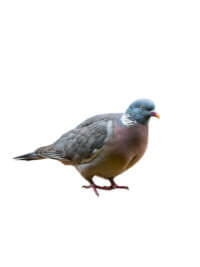WHAT DO PIGEONS LOOK LIKE

The standard pigeon has a short neck with a small head. Their short legs with level front and hind toes allow them to perch on branches as well as walk on flat surfaces. Adult pigeons are generally 12-15 inches longs. A pigeon’s normal gait includes a very characteristic motion of the head, appearing to move rhythmically forwards and backwards. Some studies have suggested that this habit aids in stabilizing their visual surroundings.
Pigeons are monogamous birds and mate for life. Both parents incubate the eggs and care for nestlings. The males build nests along coastal cliffs as well as artificial cliffs created by tall urban buildings with accessible ledges and roof spaces. Pigeons do not have natural defense mechanisms to protect against predators. Their ability to fly is the only thing between them and predators on land. Young pigeons and their eggs are also threatened by the exploding population of domestic and feral cats. Despite being on nearly every predator’s menu, pigeon populations are not in any danger of vanishing. Life expectancy varies greatly from 3-5 years through to 15 years dependent on many factors, including natural predation and human interference. You don’t want or need a bird exterminator. You may not want them roosting in and around your home or business, but you also don’t want to hurt them. That’s why you want bird control solutions that help repel and mitigate birds instead.
Pigeons are monogamous birds and mate for life. Both parents incubate the eggs and care for nestlings. The males build nests along coastal cliffs as well as artificial cliffs created by tall urban buildings with accessible ledges and roof spaces. Pigeons do not have natural defense mechanisms to protect against predators. Their ability to fly is the only thing between them and predators on land. Young pigeons and their eggs are also threatened by the exploding population of domestic and feral cats. Despite being on nearly every predator’s menu, pigeon populations are not in any danger of vanishing. Life expectancy varies greatly from 3-5 years through to 15 years dependent on many factors, including natural predation and human interference. You don’t want or need a bird exterminator. You may not want them roosting in and around your home or business, but you also don’t want to hurt them. That’s why you want bird control solutions that help repel and mitigate birds instead.